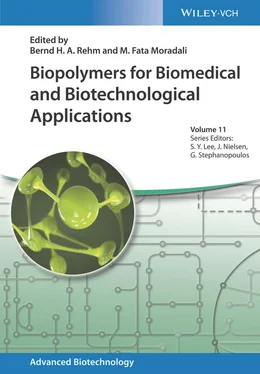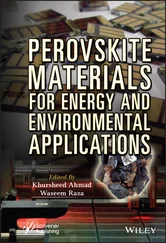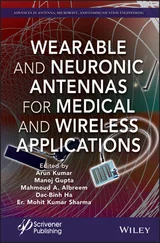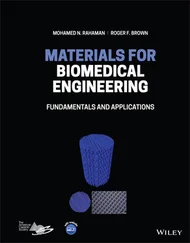1 Cover
2 Title Page Biopolymers for Biomedical and Biotechnological Applications Edited by Bernd H. A. Rehm M. Fata Moradali
3 Copyright Copyright Editors Dr. Bernd H. A. Rehm Centre for Cell Factories and Biopolymers Griffith Institute for Drug Discovery Menzies Health Institute Queensland Griffith University Don Young Road, Nathan, QLD 4111 Australia Dr. M. Fata Moradali Department of Oral Immunology and Infectious Diseases University of Louisville United States All books published by Wiley‐VCH are carefully produced. Nevertheless, authors, editors, and publisher do not warrant the information contained in these books, including this book, to be free of errors. Readers are advised to keep in mind that statements, data, illustrations, procedural details or other items may inadvertently be inaccurate. Library of Congress Card No.: applied for British Library Cataloguing‐in‐Publication Data A catalogue record for this book is available from the British Library. Bibliographic information published by the Deutsche Nationalbibliothek The Deutsche Nationalbibliothek lists this publication in the Deutsche Nationalbibliografie; detailed bibliographic data are available on the Internet at < http://dnb.d-nb.de >. © 2021 WILEY‐VCH GmbH, Boschstr. 12, 69469 Weinheim, Germany All rights reserved (including those of translation into other languages). No part of this book may be reproduced in any form – by photoprinting, microfilm, or any other means – nor transmitted or translated into a machine language without written permission from the publishers. Registered names, trademarks, etc. used in this book, even when not specifically marked as such, are not to be considered unprotected by law. Print ISBN: 978‐3‐527‐34530‐4 ePDF ISBN: 978‐3‐527‐81828‐0 ePub ISBN: 978‐3‐527‐81830‐3 oBook ISBN: 978‐3‐527‐81831‐0 Cover Design Adam‐Design, Weinheim, Germany
4 1 Advances in Biocompatibility: A Prerequisite for Biomedical Application of Biopolymers 1 Advances in Biocompatibility: A Prerequisite for Biomedical Application of Biopolymers Matthew R. Jorgensen, Helin Räägel, and Thor S. Rollins Nelson Laboratories, LLC, 6280 S Redwood Rd, Salt Lake City, UT, 84123, USA
1.1 Introduction 1.2 Biocompatibility Evaluation of Biopolymeric Materials and Devices 1.3 Using a Risk‐Based Approach to Biocompatibility 1.4 Specific Biological Endpoint Evaluations 1.5 Conclusion References
5 2 Advanced Microbial Polysaccharides 2.1 Introduction 2.2 Functional Properties and Applications of Microbial Polysaccharides 2.3 Commercially Relevant Microbial Polysaccharides: Established Uses and Novel/Prospective Applications 2.4 Hydrogels Based on Microbial Polysaccharides 2.5 Bionanocomposites Based on Microbial Polysaccharides 2.6 Bioactive Polysaccharides from Microalgae: An Emerging Area 2.7 Applications of Chitinous Polymers 2.8 Microbial Polysaccharides: A World of Opportunities Acknowledgments References
6 3 Microbial Cell Factories for Biomanufacturing of Polysaccharides 3.1 Introduction 3.2 Prominent Microbial Polysaccharides and Their Properties and Applications 3.3 Biosynthesis Pathways of Bacterial Polysaccharides 3.4 Strategies for Engineering Cell Factories 3.5 Conclusion and Future Perspective Acknowledgments References
7 4 Exploitation of Exopolysaccharides from Lactic Acid Bacteria 4.1 Introduction 4.2 Homo‐PS 4.3 Hetero‐PS 4.4 Prebiotic Activity 4.5 Conclusion References
8 5 Nanocellulose: A New Biopolymer for Biomedical Application 5.1 Trends of Biobased Polymers in Biomedical Application 5.2 Nanocellulose: Production, Characterization, Application, and Commercial Aspects 5.3 Conclusions and Perspectives References
9 6 Advances in Mucin Biopolymer Research: Purification, Characterization, and Applications 6.1 Introduction 6.2 Mucin Sources and Purification Process 6.3 Structure–Function Relation of Mucins 6.4 Characterizing Mucins and Mucin‐Based Materials 6.5 Biomedical Applications of Purified Mucins 6.6 Outlook: Engineered Mucins and Mucin‐Mimetic Polymers Acknowledgments References
10 7 Advances in the Synthesis of Fibrous Proteins and Their Applications 7.1 Introduction 7.2 Synthesis, Structure, and Characterizations of Fibrous Protein Materials 7.3 Applications of Fibrous Protein Materials 7.4 Conclusions Acknowledgments References
11 8 Microbial Polyhydroxyalkanoates (PHAs): From Synthetic Biology to Industrialization 8.1 Introduction 8.2 Synthetic Biology for Production of Kaneka PHBH 8.3 Synthetic Biology for Production of Medium‐Chain‐Length PHAs with Homogeneous Side‐Chain Lengths (Homo‐PHAs) 8.4 Synthetic Biology for Production of Lactate‐Based Polymers 8.5 Outlook References
12 9 Natural and Synthetic Biopolymers in Drug Delivery and Tissue Engineering 9.1 Introduction 9.2 Synthetic and Natural Substrates 9.3 Applications of Natural and Synthetic Polypeptides 9.4 Applications of Polysaccharides 9.5 Conclusions and Future Outlook References
13 10 Biopolymers in Regenerative Medicine: Overview, Current Advances, and Future Trends 10.1 Introduction 10.2 Biopolymer Scaffold Assembly 10.3 Organ System Specific Biopolymer Scaffolds 10.4 Summary and Outlook References
14 Index
15 End User License Agreement
1 Chapter 1 Table 1.1 Example classification and associated risks for two representative ... Table 1.2 Examples of common biopolymers. Table 1.3 Recommended TTC values from ISO 21726. Table 1.4 Standard device extraction ratios used for biocompatibility (per IS... Table 1.5 Standard body weight parameters. Table 1.6 Example of specific population doses for 1 g PLA screw.
2 Chapter 2 Table 2.1 Examples of polysaccharides produced by bacteria and fungi displayi... Table 2.2 Bionanocomposites containing polysaccharides and their applications... Table 2.3 Polysaccharide‐producing microalgae and polysaccharide characteriza... Table 2.4 Microbial chitinous polysaccharide properties and applications.
3 Chapter 4Table 4.1 Homo‐PS structure (glucans).Table 4.2 Homo‐PS structure (fructans).Table 4.3 Monosaccharide ratio in hetero‐PS from PS database and recent studi...
4 Chapter 5Table 5.1 Medical uses of synthetic petroleum‐derived polymers.Table 5.2 Current industrial producers of CNF and CNC, including country of o...Table 5.3 Testing plan to characterize safety of CNMs.Table 5.4 Extensive overview of toxicological assessment of cellulose nanofib...Table 5.5 Plant‐derived CNF‐based materials for biomedical applications.
5 Chapter 6Table 6.1 Overview of techniques employed for the characterization of mucins ...
6 Chapter 8Table 8.1 DSC analysis of PHBH with various 3HHx fractions.Table 8.2 PHBH production by phaJ expression‐regulated strains.Table 8.3 Material properties of homo‐PHAs.Table 8.4 Comparison of material properties of biobased plastics and petroleu...Table 8.5 Material properties of P(3HB), P(LA‐ co ‐3HB), and PLA [94,96].
1 Chapter 1 Figure 1.1 BioComposite Knotless SutureTak® anchor used in hip arthroscopy p... Figure 1.2 Thought process for using ISO 10993‐1 for biological evaluation o... Figure 1.3 Important aspects for setting up a chemical characterization stud...
2 Chapter 2 Figure 2.1 Schematic representation of the fabrication of chemically and phy... Figure 2.2 Macroscopic aspect of injectable chitosan‐based hydrogels at (a) ... Figure 2.3 Top view of 3D printed hyaluronic acid (6% w/v) and Dex‐HEMA (10%... Figure 2.4 Microbial polysaccharide‐based nanocomposites with metal nanopart... Figure 2.5 Deacetylation reaction of chitin to chitosan.
3 Chapter 3 Figure 3.1 Chemical structure of prominent microbial polysaccharides. Glc, gl... Figure 3.2 The mechanisms of the production of polysaccharides. Synthesis of ...Figure 3.3 Various mechanisms for determination of polymerization degree or t...
Читать дальше












